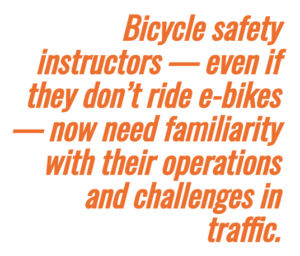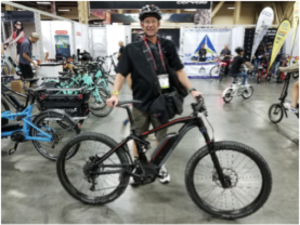Ebikes: Education, Training & The Law
Electric pedal-assisted bikes are becoming more prevalent at bicycle industry trade shows and bike shops. They’re being ridden for recreation and transportation, at MTB races, and even now by some public safety agencies across the US and beyond. My purpose in writing this post is to point cyclists and cycling instructors in the direction of educational, training, skills and legal aspects associated with e-bike use. This serves only as a starting point. Never stop learning and improving your skills, whether on a “traditional” bike or e-bike!
My experience and knowledge of e-bikes comes from riding eMTBs at Interbike trade shows, at home, and at a recent Southern California bike patrol class. I’ve also read countless articles on e-bike use in public safety and by the community. At Interbike 2017 I attended the presentations on e-biking offered by Bosch, People For Bikes and the International Mountain Bicycling Association. But don’t call me Mr. E-Bike. I’m always learning, too!
Education & Training
In her recent post “Savvy E-Biking To A Car-Free Future,” Karen Karabell writes:
[T]here’s a catch [to e-biking] many people don’t realize. With speed comes a greater need to understand the traffic environment: sight lines, door zones, blind spots, and common motorist mistakes caused by underestimating speed. Without this understanding, an e-bike may be just as likely as any other bike to gather dust in the garage after a few close calls. This is why the engagement of CyclingSavvy and e-bike owners needs to happen, and can’t be a moment too soon.
As a longtime bike patrol instructor and now bicycle safety advocate, I TOTALLY agree!
I’ll take Karen’s thoughts one step farther. Additional training and/or evaluation MUST be done for riders wanting to use an e-bike during any CyclingSavvy, Public Safety Cyclist or other bicycle safety course. This should be done prior to the start of a class (not on Day 1) to ensure the rider understands how to safely operate an e-bike and is skilled enough to use it. This also means that bicycle safety instructors — even if they don’t ride e-bikes — now need familiarity with their operations and challenges in traffic.
Important topics and basic principles that should be discussed prior to or at CyclingSavvy or other courses where cyclists ride or are considering riding e-bikes include:
- Hazards and conflicts associated with higher-speed riding. With speed comes responsibility!
- Maneuvering and stopping considerations. E-bikes are 15 pounds or so heavier than their equivalent “traditional” counterparts
- The dynamics of lane control, and a solid understanding of cyclist behaviors and how to use them. If you’re riding an e-bike at its maximum speeds, you want to do so ONLY when you’re practicing “driver behavior.” DON’T ride an e-bike fast on edge of the road, or on sidewalks
- Legal & safety issues (to be discussed below)
When e-bikes are used during any type of cycling class, they must be inspected prior to use to ensure they’re safe and adequate.
By ensuring the rider has adequate knowledge and ability to use an e-bike and that the bike is safe to use, time and attention won’t be diverted from the other students in a class. IPMBA and the agency I teach bike patrol courses for are looking at these very issues.
Safety & Legal Issues
The adage of “speed kills” is a legitimate concern when using an e-bike, both for you and fellow roadway users. As an example, a Class 3 e-bike provides assistance only when the rider is pedaling, and ceases to provide assistance when the e-bike reaches 28 mph. Twenty-eight mph!!! You must have excellent bike handling skills and know how to protect yourself when you’re riding that fast. Simply manipulating the different modes of pedal-assist can be distracting for a novice cyclist.
Cyclists using e-bikes need to know how they and their bikes work together, especially under high-speed, emergency and/or adverse conditions. As Clint Eastwood said in the movie Magnum Force: “A man’s got to know his limitations.” Therefore, the faster you intend to go, the more skill and training you need.
The Consumer Product Safety Commission and Bicycle Products Suppliers Association were the first to define e-bikes. Initially California, then other states defined and regulated e-bikes into three classes as follows:
- Class 1: Max pedal assist of 20 mph
- Class 2: Max throttle assist of 20 mph
- Class 3: Max pedal assist of 28 mph
“Conversion kits” are also available, allowing someone to turn a “traditional” bicycle into an e-bike. Cyclists should be very leery when adding this technology to their existing bicycles, especially due to the likelihood of insufficient braking systems and frames!
An NL Times (Netherlands) article from last September noted that “The number of fatal traffic accidents involving e-bikes is increasing, especially among older people.” Is this because Europe has embraced the use of e-bikes much more than the US, or because elderly people may tend to be less fit and skilled in higher-speed cycling?
Cyclists riding e-bikes both on- and off-road MUST know local, state and federal laws/regulations/definitions pertaining to all types of e-bike use, especially if they’re riding a Class 3 e-bike. This includes riding on sidewalks, bike lanes, shared-use paths and trails. I recommend e-bikers contact their local jurisdictions and/or land management agencies for up-to-date laws and regulations on where they’ll be riding.
Resources
 People For Bikes offers a handy guide to your state’s specific e-bike laws.
People For Bikes offers a handy guide to your state’s specific e-bike laws.
Lots of useful info at the Electric Bike Association, the industry voice for e-bikes.
While we don’t endorse specific products, Bosch powers many of the e-bikes on the road, and offers excellent information on the mechanics and technology of e-biking.
Bottom Line
Technology can be a wonderful thing in bringing people to cycling, and riding e-bikes is certainly FUN!!!
However, cyclists choosing to ride e-bikes — for their safety and the safety of others — NEED to take important steps to learn how to interact safely, legally and with less stress with all users of the road. A CyclingSavvy course will do that for you!
As always, be safe out there, everyone!
Next in this series: Ebike benefits and challenges – it’s a different machine.




